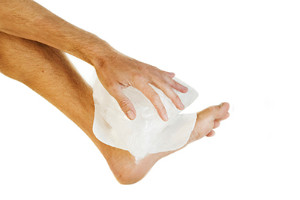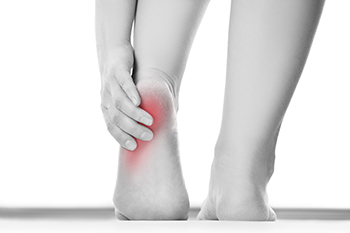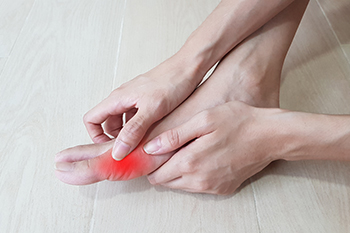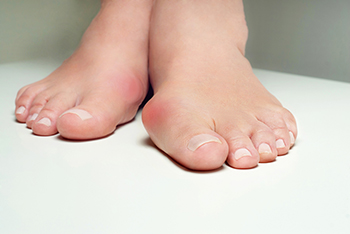

Foot pain can send ripples of discomfort through our daily activities, especially when it emanates from the bottom of the foot. This region, comprising muscles, tendons, and ligaments, is susceptible to various triggers. Plantar fasciitis, a common culprit, results from inflammation of the tissue connecting the heel to the toes. Strained arches or flat feet can lead to overuse injuries, causing discomfort along the sole of the foot. Morton's neuroma, a thickening of nerve tissue, can cause sharp pain between the toes. Excessive pressure, wearing ill-fitting footwear, or repetitive motions can contribute to this condition. Proper diagnosis by a podiatrist is essential in accurately pinpointing the cause. With tailored care and lifestyle adjustments, individuals can address the root of their discomfort. If you have pain on the bottom of your foot, it is strongly suggested that you are under the care of a podiatrist who can determine the cause and treat it accordingly.
Foot Pain
Foot pain can be extremely painful and debilitating. If you have a foot pain, consult with Massimo Pietrantoni, DPM from Rochester Podiatry, LLP. Our doctor will assess your condition and provide you with quality foot and ankle treatment.
Causes
Foot pain is a very broad condition that could be caused by one or more ailments. The most common include:
Diagnosis
To figure out the cause of foot pain, podiatrists utilize several different methods. This can range from simple visual inspections and sensation tests to X-rays and MRI scans. Prior medical history, family medical history, and any recent physical traumatic events will all be taken into consideration for a proper diagnosis.
Treatment
Treatment depends upon the cause of the foot pain. Whether it is resting, staying off the foot, or having surgery; podiatrists have a number of treatment options available for foot pain.
If you have any questions, please feel free to contact one of our offices located in Brighton and Greece of Rochester, NY . We offer the newest diagnostic and treatment technologies for all your foot care needs.

Plantar fasciitis, a common and often distressing foot condition, can disrupt daily routines with its sharp heel pain. This ailment arises from inflammation of the plantar fascia, which is the tissue connecting the heel bone to the toes. Causes can vary, including repetitive stress, wearing poor-fitting footwear, and obesity. Symptoms can manifest as intense pain upon waking or after periods of rest, and gradually easing with movement. Relief techniques can include performing stretching exercises targeting the calf muscles and plantar fascia, helping to relieve tension. Orthotic shoe inserts can provide support and distribute pressure. Taking anti-inflammatory medications can be beneficial, and for more severe cases, medical interventions such as surgery may be considered. By addressing the underlying triggers and adopting a combination of remedies, individuals can gradually step back into pain-free mobility. If you have heel pain, it is strongly suggested that you are under the care of a podiatrist who can effectively treat plantar fasciitis.
Plantar fasciitis can be very painful and inconvenient. If you are experiencing heel pain or symptoms of plantar fasciitis, contact Massimo Pietrantoni, DPM from Rochester Podiatry, LLP. Our doctor can provide the care you need to keep you pain-free and on your feet.
What Is Plantar Fasciitis?
Plantar fasciitis is the inflammation of the thick band of tissue that runs along the bottom of your foot, known as the plantar fascia, and causes mild to severe heel pain.
What Causes Plantar Fasciitis?
How Can It Be Treated?
While very treatable, plantar fasciitis is definitely not something that should be ignored. Especially in severe cases, speaking to your doctor right away is highly recommended to avoid complications and severe heel pain. Your podiatrist can work with you to provide the appropriate treatment options tailored to your condition.
If you have any questions please feel free to contact one of our offices located in Brighton and Greece of Rochester, NY . We offer the newest diagnostic and treatment technologies for all your foot and ankle needs.

Heel pain is a common ailment that can significantly impact daily activities and quality of life. Several factors contribute to heel pain, with the most prevalent cause being plantar fasciitis, an inflammation of the thick band of tissue running across the bottom of the foot. Other culprits include Achilles tendinitis, heel spurs, and bursitis. Lifestyle factors such as excessive weight, improper footwear, and repetitive overuse during physical activities can exacerbate the condition. Effective treatments for heel pain focus on reducing inflammation, managing pain, and promoting healing. Adequate rest and taking over-the-counter pain relievers may offer temporary relief. Stretching exercises and wearing orthotic inserts can provide significant relief. Early intervention and a comprehensive approach to treatment can help individuals regain their mobility and alleviate the discomfort associated with heel pain. If you have heel pain, it is strongly suggested that you consult a podiatrist who can properly diagnose the cause and offer effective treatment methods.
Many people suffer from bouts of heel pain. For more information, contact Massimo Pietrantoni, DPM of Rochester Podiatry, LLP. Our doctor can provide the care you need to keep you pain-free and on your feet.
Causes of Heel Pain
Heel pain is often associated with plantar fasciitis. The plantar fascia is a band of tissues that extends along the bottom of the foot. A rip or tear in this ligament can cause inflammation of the tissue.
Achilles tendonitis is another cause of heel pain. Inflammation of the Achilles tendon will cause pain from fractures and muscle tearing. Lack of flexibility is also another symptom.
Heel spurs are another cause of pain. When the tissues of the plantar fascia undergo a great deal of stress, it can lead to ligament separation from the heel bone, causing heel spurs.
Why Might Heel Pain Occur?
Treatments
Heel pain should be treated as soon as possible for immediate results. Keeping your feet in a stress-free environment will help. If you suffer from Achilles tendonitis or plantar fasciitis, applying ice will reduce the swelling. Stretching before an exercise like running will help the muscles. Using all these tips will help make heel pain a condition of the past.
If you have any questions please contact one of our offices located in Brighton and Greece of Rochester, NY . We offer the newest diagnostic and treatment technologies for all your foot and ankle needs.

Gout is a painful arthritis caused by uric acid buildup in the body, leading to joint redness, tenderness, and severe pain. It commonly affects the feet and specifically the big toe, but can impact other joints, like the ankles, elbows, wrists, fingers, and knees. Symptoms include intense joint pain, joint inflammation, and limited range of movement. Gout is typically more common in individuals with high levels of uric acid in their bodies. Several factors contribute to this condition, including obesity, family history of gout, being male, consuming foods higher in purines, and specific medical conditions like untreated high blood pressure, diabetes, and heart and kidney diseases. Diagnosing gout involves a physical examination and may include tests such as uric acid blood tests and joint aspiration to check for urate crystals. Adopting a healthy diet, maintaining a proper body weight to prevent obesity, and making lifestyle changes like reducing alcohol and sweetened beverage consumption can be beneficial in managing gout effectively. If you suspect you have gout, it is strongly suggested that you make an appointment with a podiatrist for a proper diagnosis and treatment.
Gout is a foot condition that requires certain treatment and care. If you are seeking treatment, contact Massimo Pietrantoni, DPM from Rochester Podiatry, LLP. Our doctor will treat your foot and ankle needs.
What Is Gout?
Gout is a type of arthritis caused by a buildup of uric acid in the bloodstream. It often develops in the foot, especially the big toe area, although it can manifest in other parts of the body as well. Gout can make walking and standing very painful and is especially common in diabetics and the obese.
People typically get gout because of a poor diet. Genetic predisposition is also a factor. The children of parents who have had gout frequently have a chance of developing it themselves.
Gout can easily be identified by redness and inflammation of the big toe and the surrounding areas of the foot. Other symptoms include extreme fatigue, joint pain, and running high fevers. Sometimes corticosteroid drugs can be prescribed to treat gout, but the best way to combat this disease is to get more exercise and eat a better diet.
If you have any questions please feel free to contact one of our offices located in Brighton and Greece of Rochester, NY . We offer the newest diagnostic and treatment technologies for all your foot and ankle needs.

If you begin to feel pain in the middle joint of your big toe, it is quite possible that you may have a bunion. This deformity is caused by prolonged pressure that compresses the big toe and pushes it toward the smaller toes. This in turn causes the middle joint to push outward, resulting in a bony bump on the side of the foot. Besides a genetic disposition to bunions, wearing shoes that are too tight or too small is a major factor in their development. Side effects from bunions include pain in the joint of the big toe, corns, calluses, and difficulty wearing shoes. In some cases, the movement of the tip of the big toe toward the other toes causes it to overlap onto the second toe. This causes problems finding appropriate footwear and can have a negative effect on posture and gait. Wearing shoes with a wider and roomier toe box is one way to reduce the effects of a bunion. Also, avoiding high-heeled shoes can help. Foot pads are available to relieve some of the pressure, as well as wearing shoes made with mesh or more flexible materials. If you have a bunion, it is suggested that you make an appointment with a podiatrist for an evaluation and recommendations for treatment.
If you are suffering from bunion pain, contact Massimo Pietrantoni, DPM of Rochester Podiatry, LLP. Our doctor can provide the care you need to keep you pain-free and on your feet.
What Is a Bunion?
Bunions are painful bony bumps that usually develop on the inside of the foot at the joint of the big toe. As the deformity increases over time, it may become painful to walk and wear shoes. Women are more likely to exacerbate existing bunions since they often wear tight, narrow shoes that shift their toes together. Bunion pain can be relieved by wearing wider shoes with enough room for the toes.
Causes
Symptoms
In order to diagnose your bunion, your podiatrist may ask about your medical history, symptoms, and general health. Your doctor might also order an x-ray to take a closer look at your feet. Nonsurgical treatment options include orthotics, padding, icing, changes in footwear, and medication. If nonsurgical treatments don’t alleviate your bunion pain, surgery may be necessary.
If you have any questions, please feel free to contact one of our offices located in Brighton and Greece of Rochester, NY . We offer the newest diagnostic and treatment technologies for all your foot care needs.